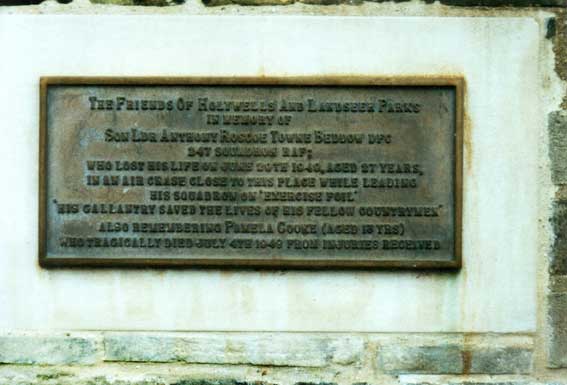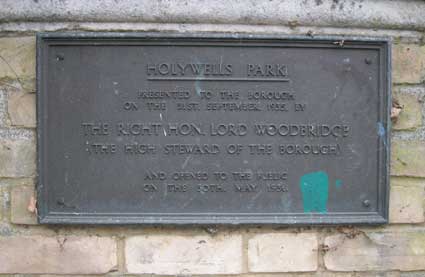'The Friends of Holywells and Landseer
Parks
in memory of
Sqn Ldr Anthony Roscoe Towne Beddow DFG,
247 Squadron RAF,
who lost his life on June 29th 1949, aged 27 years,
in an air crash close to this place while leading
his squadron on 'Exercise Foil'.
'His gallantry saved the lives of his fellow countrymen'
Also remembering Pamela Cooke (aged 13 years)
who tragically died July 4th 1949 from injuries received.'
This small cast iron memorial can
be found to the left of the
Myrtle Road entrance to Holywells Park
(see below). A small reminder of
life and
death in the air after the Second World War.
Here is Alan Capon's reminsences from http://www.countyweeklynews.ca
(a curious Californian website which seems also to feature East Anglia)
dated Thursday, November 19, 2009:
"Sixty years ago, late in the afternoon of June 29, 1949, I had just
entered the main gates of Holywells Park in my hometown of Ipswich when
I heard a very loud noise. Looking into the park I saw an aircraft
strike the roof of a semi-detached house on Myrtle Road then crash
through the wall of the park into some tall trees.
As I walked further into the park I could see smoke and flames flare up
high into the trees. The remains of the pilot had been thrown some
distance from his aircraft.
The fallen aircraft was an RAF De Havilland Vampire, a single-engine
jet fighter with a distinctive twin boom configuration. I learned many
years later that the aircraft, at the time, had been engaged in a
simulated dogfight with an RAF De Havilland Hornet aircraft.
I left the park and returned home and I did not learn anything more
about this tragic event until, 51 years later, I read on the Ipswich
Evening Star web page of the dedication of a plaque honouring the
27-year old pilot, Squadron Leader Anthony Roscoe Towne Beddow who had
fought to steer his disabled plane into the park to avoid crashing into
the houses below.
The plaque fixed to the wall of Holywells Park remembers Sqn. Ldr.
Beddow and also a 13-year old girl, Pamela Cooke, who was in Myrtle
Road when the aircraft struck the roof of a house two doors from her
home. She suffered burns from the spilled fuel and died from her
injuries five days later.
The pilot's twin sons, Barry and Matthew, were just two months old when
their father died. They were present at the unveiling of the memorial
plaque in 2003.
I revisited the site of the crash in Holywells Park while on holiday in
England in October, 2003 and read the poignant words on the memorial
plaque.
Looking back over the years on this tragic event it seems to me, today,
that a high-speed, low-level flight and simulated dog-fight by two
military aircraft directly over a town should never have been
authorized.
In 2008, David Kindred, the now retired photo editor of the Evening
Star, recently came across a copy of the local police report on the
incident. The report, Kindred said, shows how very basic the
investigation into the crash was. Today, Kindred said, the site of an
air crash would be closed for days while every possible detail was
recorded.
Myrtle Road is a short street but this was the second time a major
tragedy had occurred there. On June 2, 1943, during the Second World
War, 11 people were killed in an air raid on town. One bomb landed on
houses in Myrtle Road killing Mr. and Mrs. Smith at number 44, a few
yards from where the Vampire later crashed.
During this Second World War bombing raid a German aircraft flew
through the blast of the bomb causing it to crash into a crane at the
Ipswich docks.
These memories of past days during and immediately after the war
flooded back to me at this year's Remembrance Service in Picton."
 2001
image
2001
image 2001
image
2001
image
 2014
images
2014
images